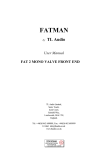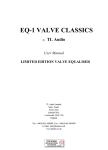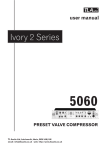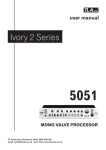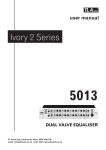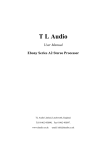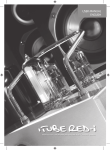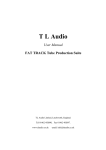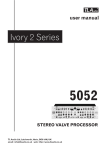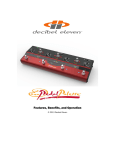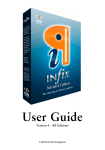Download Here`s - TL Audio
Transcript
user manual FAT MAN ® by TLAudio TL Audio Limited, Sonic Touch, Iceni Court, Icknield Way, Letchworth, SG6 1TN England Tel: +44 (0)1462 680888 Fax: +44 (0)1462 680999 email: [email protected] web: http://www.tlaudio.co.uk FAT 1 stereo valve compressor CONTENTS 1 INTRODUCTION 2 PRECAUTIONS 3 INSTALLATION 3.1 3.2 3.3 3.4 3.5 3.6 A.C. Mains Supply Line Inputs Instrument Inputs Outputs Operating Level Ventilation 4 OPERATION 4.1 4.2 4.3 4.4 4.5 4.6 4.7 4.8 4.9 4.10 4.11 4.12 4.13 What is Compression? Why Valve Compression? Overview of Compressor Operation Input Gain Output Gain Gain Make Up Program Control Threshold Ratio Attack and Release Knee Meter Compressor On 5 GETTING STARTED 5.1 5.2 5.3 Connection In Use Frequently Asked Questions (FAQ) 6 SERVICE 7 SPECIFICATIONS 1 INTRODUCTION Congratulations on purchasing the Fatman FAT 1 stereo valve compressor by TL Audio! The FAT 1 is the first valve compressor to combine fully adjustable controls with fifteen preset compression programs, allowing you the choice of creating your own unique settings or opting for our wide selection of factory programmed presets. Now at last you have access to professional sounding high quality valve compression for both tracking and mixing. The FAT 1 combines classic valve techniques with solid state circuitry (known as a “hybrid” design) in order to achieve the best combination of noise performance and valve warmth. This makes the FAT 1 ideal for integration into both analogue and digital recording systems, where extra warmth is required without the penalty of increased noise levels. The block diagram of the FAT 1 is shown in Figure 1. A solid state, electronically balanced input amplifier is used to achieve state of the art performance with very low noise, low distortion and wide bandwidth. An ECC83/12AX7A triode valve stage (run from a stabilised 100v DC supply) is used as a second stage voltage amplifier, to obtain the classic valve sound and gradual overdrive characteristics. Like all other TL Audio compressors, the gain control element of the FAT 1 is based around a special transconductance amplifier, which avoids the use of VCAs and helps contribute to the smooth, open sound of the unit. A certain degree of program dependant response is built into the FAT 1, particularly for the attack and release times, and both soft and hard knee responses are obtainable. The FAT 1 is a stereo compressor, with a single set of controls to control both left and right channels. The unit works in linked stereo mode at all times, whereby the control voltages of left and right channels are linked to ensure that the same amount of gain reduction is applied to both channels (even if one signal is below the threshold). This ensures that the stereo image is preserved. However, the FAT 1 may be used in mono by employing the left channel only, although the processed signal will appear on both outputs simultaneously. A single illuminated VU meter monitors the output level or gain reduction for both channels. Line inputs and outputs are provided on each channel, on electronically balanced jack connectors. These are fully compatible with unbalanced signals, and the operating level of the ins/outs can be shifted from -10dB to +4dB via a rear panel switch. A pair of front panel instrument inputs are also provided, thus allowing guitars, basses and keyboards to feed directly into the FAT 1, removing the need for a separate DI box. Please read this manual fully before installing or operating the FAT 1. 2 PRECAUTIONS The FAT 1 Stereo Compressor requires very little installation, but like all electrical equipment, care must be taken to ensure reliable, safe operation. The following points should always be observed: - All mains wiring should be installed and checked by a qualified electrician, - Ensure the correct operating voltage is indicated on the rear panel before connecting to the mains supply, - Never operate the unit with any cover removed, - Do not expose to rain or moisture, as this may present an electric shock hazard, - Replace the fuse with the correct type and rating only. Warning: This equipment must be earthed. 3 INSTALLATION 3.1 AC Mains Supply. The compressor is fitted with an internationally approved 3 pin IEC connector. A mating socket with power cord and mains plug is supplied. All mains wiring should be performed by a qualified electrician with all power switched off, and the earth connection must be used. The unit is specified for operation on nominal 230V a.c. mains only. If the power cable or mains plug supplied with the unit is not suitable for use in your country, refer to your dealer for a replacement. Warning: attempted operation on the wrong voltage setting, or with an incorrect fuse, will invalidate the warranty. 3.2 Line Inputs. Each channel has a 3 pin TRS jack socket on the rear panel, which will accept balanced or unbalanced line inputs providing the mating plug is suitably wired: Balanced inputs: - Screen = Ground, - Tip = Signal Phase (“+” or “hot”), - Ring = Signal Non-Phase (“-” or “cold”). Unbalanced inputs: - Screen = Ground, - Tip = Signal Phase (“+” or “hot”), - Ring = Ground. Good quality screened cable should be used, particularly for microphone or low level sources, to prevent hum or noise pickup. Refer to Figure 3 for rear panel connector identification. 3.3 Instrument Inputs. Each channel has a 0.25” jack socket on the front panel (see Figure 2). A 2 pin (mono) jack plug is required, which should be wired as follows: - Tip = Signal Phase (“+” or “hot”), - Screen = Ground. 3.4 Outputs. The outputs via 3 pin TRS jack sockets on the rear panel, and may be configured for balanced or unbalanced connection. Balanced operation is always preferable to maintain maximum headroom and signal to noise ratio, but can only be used if the following equipment is also capable of balanced operation: Balanced outputs: - Screen = Ground, - Tip = Signal Phase (“+” or “hot”), - Ring = Signal Non-Phase (“-” or “cold”). Unbalanced outputs: - Screen = Ground, - Tip = Signal Phase (“+” or “hot”), - Ring = Ground. 3.5 Nominal Operating Level. A switch on the rear panel allows the line inputs and outputs to be matched to equipment at a nominal operating level of +4dBu or -10dBu. Most professional equipment requires +4dBu (approximately 1.2V rms), but some small mixing consoles, portable tape recorders or domestic audio equipment require -10dBu (approximately 225mV rms). If the operating level is not known, the switch should be set to the position which results in the best signal to noise ratio, whilst preserving sufficient headroom. 3.6 Ventilation. The FAT 1 generates a small amount of heat internally, mainly due to the valve heater. This heat should be allowed to dissipate by convection through the top grill, which must not be obstructed. Do not locate the compressor where it will be subject to external heating, for example, in the hot air flow from a power amplifier or on a radiator. The FAT 1 may be free standing (using the self-adhesive feet supplied), or mounted singly or in pairs in the optional FAT-RACK 3U high 19” rack tray. 4 OPERATION 4.1 What is Compression? Compression is an essential but often misunderstood process in modern recording. Put simply, compression reduces the ratio between the loudest and the quietest levels of an audio signal, which is known as reducing the “dynamic range” of that signal. Before the introduction of compressors the only way this could be achieved was by “gain riding”, whereby an engineer would control the fader manually in order to try and anticipate very large levels (which might distort the signal) or very low levels (which may get lost in noise). The introduction of compression devices meant that this process could be controlled automatically, allowing the engineer to get on with more productive jobs! Many instruments and voices have a very wide dynamic range which needs to be controlled. A singer, for instance, may be singing quietly one moment and very loudly the next, and unless compression is applied the vocal won’t “sit” correctly in the mix, in addition to the problems of distortion on loud passages and noise on quiet ones. Thus with compression you are effectively turning down the loud bits and turning up the quiet bits, to achieve a more even and controllable level. But there are other benefits of compression as well - applied properly, it can add punch and excitement to music, as well as fattening up sounds and creating a more professional sounding recording. With the FAT 1, you have the added benefit of valve stages in the signal path, which create a warmth and presence just not obtainable with solid state or digital products. 4.2 Why Valve Compression? Valve compression yields a particularly special sound which has become very sought after, particularly with the widespread use of digital products. The reason valve equipment sounds special is due to two things: harmonic distortion and natural compression. When the signal through a valve is increased, it tends to generate a particular type of subtle and desirable distortion, called “second harmonic” distortion. This has the effect of thickening and warming the sound, and the more the level you feed to the valve stages, the more of this harmonic distortion will be produced. You should be able to hear this effect as you increase the Input Gain on the FAT 1. Secondly, valves will tend to naturally compress an audio signal, again particularly as the signal level is increased. This itself also contributes to the warmth produced by the FAT 1. 4.3 Overview of Compressor Operation. The FAT 1 offers two distinct ways of working: manual or preset modes. In manual mode, all the compressor controls are active and adjustable, so that compression settings can be created from scratch to suit the user’s taste. In the fifteen preset modes, the Threshold, Ratio, Attack, Release and Knee controls are disabled and each is fixed internally at a value that is selected to give the best results with that particular instrument (the presets are titled ‘vocal’, ‘bass’, ‘guitar’, ‘snare’ etc. to indicate the recommended application). The FAT 1 functions by reducing the gain of the signal when it rises above a certain level, known as the Threshold. Any signal below the threshold passes through the unit unaffected. Above the threshold the gain of the signal is reduced, and the degree of gain reduction is determined by the Ratio control. The Ratio control is calibrated in dBs and is simply the change in output level that results from a given change in input level. The Attack and Release switches are used to control how fast the compressor reacts to the audio signal. The Attack switch governs how quickly the FAT 1 acts to compress the signal once it has risen above the threshold, while the Release switch controls how quickly the signal returns to normal once it has dropped back below the threshold level. The Knee switch controls the shape of the FAT 1 compression curve. In “Soft Knee” mode, the response curve of the compressor around the threshold is gentle, so that the compression effect is more subtle and musical. In “Hard Knee” mode, the curve is more severe, so that signals above the threshold are “squashed” more aggressively. This yields a more audible and pronounced compression effect. The Gain Make-Up control is positioned at the output of the compressor stage, and allows the signal level to be brought back to the same loudness as the uncompressed signal. 4.4 Input Gain. The Input Gain control sets the level of the signal to the input stage of the compressor and is variable between -20dB and +20dB. This allows a wide range of signals to be fed into the FAT 1, and also allows the valve stages to be driven to a variable degree. Each channel of the FAT 1 has a triode valve stage positioned between the input circuit and the compression stage. Increasing the input gain pushes more signal level into the valve, thus generating more harmonic distortion and creating that special “valve sound”. At the same time the output level can be turned down to preserve the same level at the outputs, so a choice of sounds is available. For a more pronounced valve sound, turn up the input gain and reduce the output gain, and vice versa for a cleaner sound. Don’t be afraid to push the FAT 1 hard! As well as driving the valves harder, increasing the Input Gain control setting will also tend to push the signal towards and possibly over the compression threshold setting, so this control will have a pronounced effect on the amount of compression taking place, even in the Preset modes. The Input Gain control is active at all times, whether the Program control is set to Manual or Preset modes. 4.5 Output Gain. This controls the level at the FAT 1 outputs, and again is variable between -20dB and +20dB. This control effectively acts like an output fader, and is very useful when recording direct to tape or hard disc through the FAT 1. You may find that some digital recorders require a good deal of input level in order to register a 0dB reading on their meters. This is normal, since many digital recorders are designed to preserve headroom and keep the signal well below the 0dB clip point - thus preventing the recorder distorting. The FAT 1 provides ample gain to drive digital recorders, but you may find that the Output Gain control has to be set to higher levels for this reason (see also section 3.5 on operating level). The Output Gain control is active at all times, whether the Program control is set to Manual or Preset modes. 4.6 Gain Make Up. While the subjective sound quality of the signal can be improved by compression, the overall signal level will be reduced when gain reduction is taking place. The Gain Make Up control is designed to boost the compressed signal by between 0 and 20dB, in order to bring back the level to the same loudness as the uncompressed signal. Without this control, comparing the original and compressed signals becomes difficult, since there would be a level drop each time the compressor is switched in: therefore it is normal to adjust the Gain Make Up control so that when the ‘compressor on’ switch is activated, the audio signal remains constant in level. Unlike the Output Level control, the Gain Make Up control is active only when the ‘compressor on’ switch is engaged. Once the Gain Make Up has been adjusted, use the Output Level control to set the overall output level of the FAT 1. Assuming the compressor is activated, the Gain Make Up control is active whether the Program control is set to Manual or Preset modes. 4.7 Program Control. This 16 way rotary switch enables factory preset compression settings to be selected for different types of audio signal. The ‘Manual’ mode enables the Threshold, Ratio, Attack, Release, and Knee controls to be adjusted, along with the Input Gain, Output Gain and Gain Make Up controls (which are active at all times). In this mode the FAT 1 works like a standard compressor in the sense that the user can create their own unique compression setting and have full control over it at all times. In all the other 15 program settings, the Threshold, Ratio, Attack, Release and Knee controls are pre-selected and fixed within the FAT 1 to give optimum results for that given type of signal. Thus these controls are disabled and will have no effect when adjusted, unless the user returns to ‘Manual’ mode. In the Preset modes, all the user has to do is select the required preset and then adjust the Input Gain, Output Gain and Gain Make Up to taste (see particularly section 4.4 on Input Gain) The 15 presets are shown in Table 1. The way the Program control works is by using a digital switching circuit to replace the controls mentioned by a series of fixed components (in the case of Threshold and Ratio) and on/off switch values (in the case of Attack, Release and Knee). This doesn’t mean that the signal itself is converted to digital format within the FAT 1: it simply means that the signal parameters are controlled digitally. How did we create the Program settings? Simply by operating the unit in Manual mode and arriving at an optimum set of adjustments for vocals, keyboards, basses, guitars, drums and stereo mixes. These settings were then programmed into the FAT 1, and as a result we’ve detailed the settings for each preset in Figure 4, should you wish to re-create any of the presets in manual mode, and adjust them to suit your own application. Figure 4 1: Vocal 1 2: Vocal 2 Knee* Soft Soft Hard Soft Attack* Fast Fast Fast Release* Fast Slow Slow PRESETS " 3: Vocal 4: Keyboards 5: Bass 3 1 6: Bass 2 7: Ac. Guitar 8: Electric 9: Electric Guitar 1 Guitar 2 10: Snare 11: Kick 12: Kit 13: Mix 1 14: Mix 2 15: Mix 3 Soft Soft Soft Soft Hard Hard Hard Soft Soft Soft Hard Slow Slow Slow Fast Fast Fast Fast Fast Fast Fast Fast Fast Slow Slow Slow Fast Fast Fast Fast Fast Fast Fast Slow Slow CONTROLS # Input Gain Output Gain Gain Make-Up Threshold* Ratio* * The settings shown for these controls are fixed internally for each preset, and are non-adjustable (except in Manual mode). The Input Gain, Output Gain and Gain Make-Up controls are user-adjustable at all times - the values shown are recommendations. Table 1: Presets. Number 1 Preset Title Vocal 1 2 Vocal 2 3 Vocal 3 4 Keyboards 5 Bass 1 6 Bass 2 7 10 Acoustic Guitar Electric Guitar 1 Electric Guitar 2 Snare Drum 11 Kick Drum 12 Kit 13 Mix 1 14 Mix 2 15 Mix 3 8 9 4.8 Typical Applications Light, subtle compression for softer vocal performances. Soft knee, fast attack and release. Medium compression for more obvious control. Soft knee, fast attack and slow release. Hard compression for powerful performances. Hard knee, fast attack and slow release. Designed for synth pads, strings etc. Soft knee, slow attack and release. Medium compression for electric, acoustic and synth basses. Soft knee, slow attack and release. Harder compression for electric, acoustic and synth basses. Soft knee, slow attack and release. Soft knee, fast attack and fast release. Medium compression for recorded or DI’d guitars. Soft knee, fast attack and release. Harder compression for recorded or DI’d guitars. Hard knee, fast attack and release. For tight control of snares. Hard knee, fast attack and release. For tight control of kick drums. Hard knee, fast attack and release. Ideal for compressing stereo acoustic drum kits, drum machines and sampler drum loops. Soft knee, fast attack and release. Lighter compression suitable for pop mixes. Soft knee, fast attack and release. Medium compression suitable for rock mixes. Soft knee, fast attack and slow release. Heavy compression suitable for dance mixes. Hard knee, fast attack and slow release. Threshold. The FAT 1 functions by reducing the gain of the signal when it rises above a certain level, known as the Threshold. Any signal below the Threshold passes through the unit unaffected, while signals above the Threshold have their gain reduced (and are thus ‘compressed’). The FAT 1 has a variable Threshold control, adjustable between +10dBu and -20dBu. Unlike some compressors, the Threshold control on the FAT 1 starts at a ‘plus’ value in the counter-clockwise position, and decreases to a ‘minus’ value as you rotate the control clockwise. The reason for this is as you turn the Threshold control on the FAT 1 clockwise (i.e. towards the negative region) then the degree of compression will increase. We think this is logical, whereas the common method of turning the control ‘down’ to achieve more compression is not - but beware, some other compressors may work in this way! The Threshold control is only active when the Program control is set to Manual mode. In all of the Preset modes it is disabled and the Threshold value is fixed internally. 4.9 Ratio. Once the input signal has crossed the threshold, the degree of gain reduction is determined by the Ratio control. The Ratio control is calibrated in dBs and is simply the change in output level that results from a given change in input level. An uncompressed signal will have a 1:1 compression ratio - every 1dB change in input level results in the same 1dB change in output level. A compression ratio of 1:3, for instance, means that a 3dB change in input level will only give a 1dB change in output level. For more severe compression, simply turn up the Ratio control. The FAT 1 offers a wide range of ratios from 1:1.5 (gentle compression) through to 1:30 (limiting). Limiting effectively clamps the input signal at the threshold level no matter how much the signal is increased: this can be useful when trying to ensure that the signal doesn’t exceed a certain level - for instance to prevent a digital recorder distorting through overload. The Ratio control is only active when the Program control is set to Manual mode. In all of the Preset modes it is disabled and the Ratio value is fixed internally. 4.10 Attack and Release. The Attack time of the FAT 1 is switchable between 0.5mS (‘Fast’) and 5mS (‘Slow’). At 0.5mS attack, the compressor is fast enough to compress a 1KHz signal in less than half a cycle, effectively preventing the overload of any following equipment which has limited headroom, such as a digital processor, tape machine or transmitter. Fast attack times are used to compress a signal quickly, so are suitable for audio signals with sharper transients such as drums. However, if you want the initial leading edge of the signal retained (for instance the initial click of a bass guitar) then a slower attack time can be employed, and slow attack times can also be useful on sustained sounds like synth pads. The Release time of the FAT 1 is switchable between 0.2S (‘Fast’) and 1.5S (‘Slow’). The Release setting is important because if it is too short, the compressor gain recovers too quickly with the result that there is an audible ‘pumping’, ‘breathing’, and sometimes low frequency distortion. In these cases try using a slow release time. Adjustment of the attack and release times allows unobtrusive compression to be applied to virtually any audio signal, but should very short transients occur the time constants become signal dependent, generally reduced, to prevent a slow release leaving a ‘hole’ in the signal after the transient. Also, a fast release setting will be extended by a slow attack setting. This type of automatic control means that the flexibility of the FAT 1 is greatly extended without the extra complication of fully variable attack and release controls. The Attack and Release controls are only active when the Program control is set to Manual mode. In all of the Preset modes they are disabled and the Attack and Release values are fixed internally. 4.11 Knee. The Knee switch enables the FAT 1 to be operated in two different modes - Soft Knee or Hard Knee. Soft Knee mode offers a gentle compression curve around the threshold point, and is traditionally employed to yield a more subtle, musical type of compression effect. The Hard Knee setting causes the full compression ratio to be applied immediately the signal has passed the threshold point, so tends to produce more pronounced and severe compression. The Knee control is only active when the Program control is set to Manual mode. In all of the Preset modes it is disabled and Knee setting is fixed internally. 4.12 Meter. The FAT 1 is equipped with an illuminated VU meter. The Meter switch enables the FAT 1’s VU meter to monitor one of two parameters. When switched to ‘Output’ the meter reads the audio output level, and is calibrated to read 0VU for a +4dBu output level. The reference point may be internally adjusted by your dealer if required. Increasing the Output Level control on the FAT 1 towards the +20dB setting will cause the FAT 1’s meter to move further towards the red area and possibly to the end of the scale if sufficient gain is applied. This is normal, particularly if driving a digital recorder where large input levels are required. The meter may be switched to indicate the amount of compression occurring. If the signal is below the threshold, the meter will indicate 0dB: i.e. no gain reduction. As the signal passes through the threshold, the meter will start to indicate the gain reduction at the compressor stage (this will be a negative value, so the meter will move to the left, away from 0VU). Note that this reading won’t include any extra gain make-up applied. 4.13 Compressor On. This switch enables or disables the compressor stage, thus allowing an A/B comparison to be made between the original untreated signal and the compressed signal. An associated status LED indicates when the compressor is active. 5 GETTING STARTED 5.1 Connections. There are various ways that the FAT 1 can be connected into your audio system. The three most common are: a) As an instrument front end b) Connected to a channel insert point c) Connected to a group or master insert point To use the FAT 1 as an instrument front end, connect the output(s) of the FAT 1 directly to the line (not mic) input of your console, recorder or sound card. The FAT 1 has balanced line outputs for professional sound quality, but can easily connect to an unbalanced line input (see Installation section 3.2). Once the outputs are connected, simply feed your instrument into the front panel jack input(s) on the FAT 1. Recording direct to the multitrack recorder (thus bypassing the console) is a common technique these days as it keeps the signal path short, and of the highest quality. No unnecessary console stages are passed through, thus maintaining quality. Many mixers have sockets called ‘insert points’, which allow processors such as dynamics devices and EQs to be patched in-line into the mixer signal path at various points. The most common points that insert points are provided are in the channel, group and stereo master sections. Patching the FAT 1 into the channel insert point means that any signal passing through that channel will pass directly though the FAT 1. Compressing a vocal, for instance, can be achieved by connecting the microphone directly to the console mic input, then connecting the FAT 1 into the console insert point. The mixer will amplify the mic signal before being passed into the FAT 1’s inputs via the mixer insert ‘send’ connection. The outputs of the FAT 1 connect back to the insert ‘return’ connection, thus returning the signal to the mixer and ensuring continuous signal flow. Group insert points are used to compress sub-grouped signals such as drums or backing vocals. It’s common to mix an entire drum kit to a stereo group, then use a pair of group faders to control the overall level, rather than having to adjust each individual drum level. If you then wish to compress the overall stereo kit signal, you can connect the FAT 1 to the relevant group insert points, using the same ‘send and return’ technique as the channel insert. Having compressed individual tracks while recording, it is common to apply compression to the stereo mix while mastering it to 2-track tape, DAT or CD. Doing this will help fatten the sound further and control levels. Like the channel and groups, the stereo L/R mix buss will normally have a pair of insert points to facilitate this. If not, the FAT 1 can be connected in-line with the mixer’s main stereo outputs, ahead of the master 2-track recorder. 5.2 In Use. Having connected the FAT 1, it’s time to put it into action! Here’s a simple step by step guide: a) The first stage is to set up the gains of the unit. With the Compressor switched out, start with the Input and Output Gains and Gain Make-Up at 0dB. b) With the Meter set to read ‘Output’, adjust the Input Gain to achieve a peak reading of around 0VU with the chosen source material. c) If more output is then required then adjust the Output Level control accordingly. d) Now depress the Compressor ‘On’ switch, and depress the Meter switch to read ‘Gain Reduction’. e) Using the Program control, select a suitable preset to suit the instrument or mix you are listening to. f) The meter should now register that some gain reduction is taking place. If not, or you wish more gain reduction to occur, increase the setting of the Input Gain control. g) When gain reduction is taking place, you should notice that the output level is reduced. By switching the Compressor On switch in and out; you can compare the levels and the subjective sound quality of the original and compressed signals. With the Compressor active, use the Gain Make-Up control to set the level so that when disabling the compressor, there is no level drop. This way you can A/B the signals without the levels changing. h) Switch to Manual mode. You will now find that the Threshold, Ratio, Attack, Release and Knee controls become active. Start with the Threshold at +10dB, Ratio at 1:3, Attack and Release at ‘Fast’, and Knee at ‘Soft’. i) While continuing to meter gain reduction, gradually turn the Threshold clockwise towards -20dB. While doing this you’ll notice that compression will start to take place and the meter will start to register some gain reduction. The further towards 20dB you move, the greater the gain reduction that occurs. Aim to get around a maximum 3-4dB of gain reduction occurring as a starting point. You should also notice that increasing the Ratio setting causes more gain reduction to occur. By referring to Figure 4, you can see the settings that we have used to create the fifteen program presets, so you may want to manually duplicate these settings and then use them as a starting point, then adjust to suit your own tastes. 5.3 Frequently Asked Questions (FAQs). Q: A: The FAT 1 is a stereo unit yet there is only one set of controls, Why is this? The FAT 1’s single set of controls affect both channels simultaneously, since the unit always works in linked stereo mode. To operate in mono mode, simply run your mono signal through the left channel input/output (either the line input, or the instrument input if applicable). Q: A: The Threshold, Ratio, Attack, Release and Knee controls aren’t working. This is because the Program control is not set to Manual mode, and these parameters are all fixed within the FAT 1. Q: A: Why is it I occasionally get some LF distortion on certain settings? This happens when a Fast Release time is selected on certain bass-heavy sources. The compressor is then forced in and out of gain reduction within an individual cycle, and thus distortion is caused on the lower frequencies. Selecting a slow attack/release time will cure the problem. Q: A: Can I use the preset settings on instruments other than those recommended? Absolutely. If it sounds good, use it! Q: A: The Gain Make-Up control isn’t working. This control is only active when the ‘Compressor On’ switch is engaged. Q: A: The FAT 1 is a stereo unit but there is only one valve in it. Why? The unit employs a single ECC83/12AX7A dual triode valve, so called because it features two separate valve stages within one glass housing. Each channel of the FAT 1 employs one of these stages. Q: A: How long do the valves last before they need replacing? This very much depends on the valve itself, whether the unit is left switched on all the time and how much the unit is moved around. On average we’d say about three years. The valve itself is easily sourced and relatively inexpensive contact your dealer for details. 6 SERVICE Should the FAT 1 require service, it must be taken or posted to an authorised dealer with a description of the fault. Please retain the original packing for possible future use, and ensure the unit is suitably protected during transit. The manufacturer cannot accept responsibility for damage caused during transportation. The FAT 1 is supported by a limited warranty for a period of one year from the date of purchase. During this period, any faults due to defective materials or workmanship will be repaired free of charge. The warranty excludes damage caused by deliberate or accidental misuse, tampering, operation on the incorrect mains voltage, or without the correct type and value of fuse fitted. It is the user’s responsibility to ensure fitness for purpose in any particular application. The warranty is limited to the original purchase price of the equipment, and excludes any consequential damage or loss. When claiming service under warranty, proof of purchase date must be included with the equipment for repair. Please record the following details, and retain proof of purchase: Serial Number............................. Date purchased........................... Dealer......................................... TL Audio Limited, Sonic Touch, Iceni Court, Icknield Way, Letchworth, SG6 1TN, England.



















